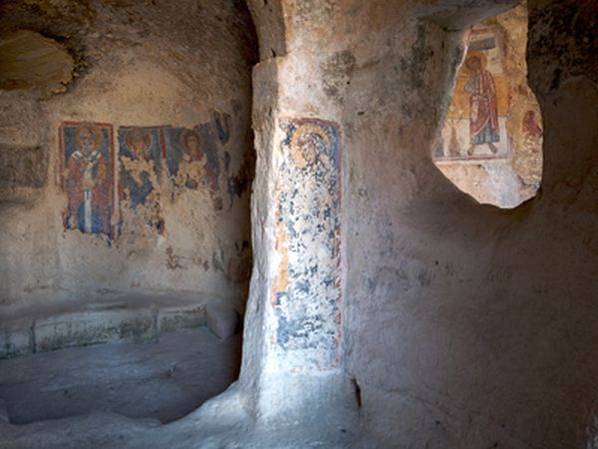
Monastic settlement dating back to the 10th century, San Nicola dei Greci is located on the church of Madonna delle Virtù and was used until 1956 as a private residence. The original layout is not easily recognizable as the structure underwent the collapse of the classroom in ancient times, but we can recognize two parallel apsidal naves and an arched iconostasis. In 1978 the valuable frescoes that enrich it were restored: in the apsidal basin of the right nave, also used as a sepulchral pit, as well as the plateau above, there is a fourteenth-century Crucifixion, enclosed in a red frame, in which Christ has his head reclined on the right arm, and on the sides the Madonna with an intense expression and Saint John the Evangelist holding the scroll of the Gospel in his hand. Note the flowers that bloom on the sides of the crucifix: many have recognized in them the characteristic “asphodels” which are part of the characteristic flora of the Matera Murgia Park, which enjoys a splendid view from the terraces in front of this ancient place of worship.
The triptych of saints in the left nave is composed, respectively from right to left, of Santa Barbara (13th century), with rich imperial robes and canonical coppery hair, St. Nicholas (14th century), in a Dalmatian and blessing Greek dress, and San Pantaleone (13th century), who holds a casket with ampoules symbol of his profession as a doctor. Next: Madonna with a thirteenth-century child, of oriental inspiration unfortunately in a bad state of conservation. Entering to the right, however, there are two frescoes later: St. Peter martyr with the symbols of his martyrdom, and St. Anthony, both from the sixteenth century.
In front of the church, an excavation carried out in 1977 returned material from a Bronze Age furnace and finds from the early Middle Ages. To see the surroundings of the church: a series of houses, utility rooms, such as the one with the settling tank on the ground that feeds the numerous cisterns present, and the bell-shaped silos dug into the rock and used to store food and grains.